Do you get the impression that Super Mario Bros.‘s levels are somehow getting smaller? Ah, well, that’s because they are. World 1-4 is the briefest level yet, clocking in at a couple of screens shorter than 1-3, which in turn was shorter than the stages that preceded it as well. But it makes sense: This is the culmination of the game, the final showdown. After three varied obstacle courses, this stage represents an even purer and more straightforward set of challenges than ever before, focused primarily on building up to the conclusive battle with Bowser.
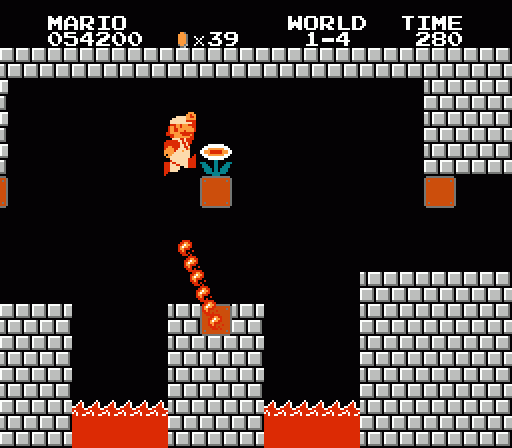
World 1-4 lacks any enemies save the big guy at the end. It’s simply a showdown with the boss, the Koopa King himself. Don’t mistake the path to the end as a gentle cakewalk, though. Despite really only incorporating three threats (plus Bowser), World 1-4 can be downright nasty if you don’t have a handle on the game’s controls yet.
The first of the level’s hazards is a pair of pits — nothing new, though these are filled with lava. Empty pit or magma pit, they’re fatal just the same if you fall in. The lava wallpaper here simply helps set the mood, along with the inky blackness of the background and the tense, intense music. This feels like something big and deadly. You’re in the enemy’s lair… though actually it’s Princess Toadstool’s castle, right? Either Bowser did some major renovations upon his conquest of the Mushroom Kingdom or else the gentle princess has some grim taste in interior decorations.
The second hazard presents itself for the first time right between those lava pits: The fire bar.
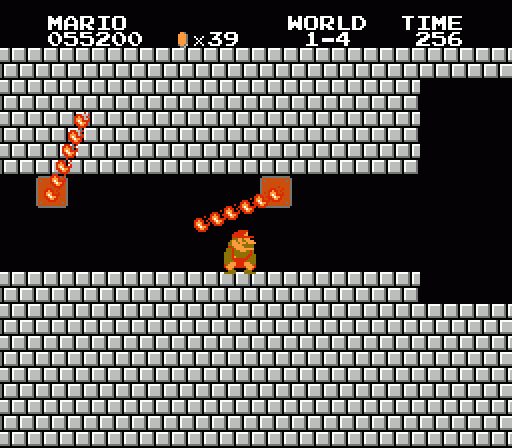
Fire bars are a simple but dangerous threat. Consisting of six (sometimes more) linked balls of fire, they turn Mario’s best weapon against him. They revolve around a central fireball that serves as a fulcrum, anchored into a null block. Fire bars can rotate either clockwise or counter-clockwise, and they’re just barely slow enough in their movements for Mario to squeak past if he hustles. Thankfully, they don’t register as a solid obstacle, so if you let yourself collide with one you can run through it as you shrink. Provided you’re Super Mario to begin with, of course.
Your introduction to fire bars forces you to make a tough decision right from the start. That first bar swings on a pivot on a narrow isthmus of brick in a sea of lava, directly beneath a Question Block containing the sole power-up in the stage. It’s entirely possible to dodge the fire bar, hit the block, and collect the power-up inside — but it takes skill and careful maneuvering. Alternately, you can very easily bypass the fire bar altogether by using the Question Block as a platform to carry you over the hazard, but in doing so you also pass up the power-up inside.
The further we venture into this game, the more perilous acquiring power-ups will become. This is your first real taste of that philosophy, and it introduces a new hazard in the process.
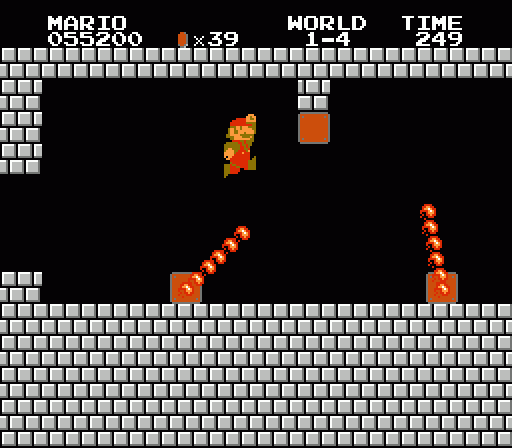
Past the pits you need only worry about the fire bars; no tricky platforming necessary. There are five more fire bars in total, becoming progressively more dangerous as you go. The first two block a narrow corridor by swinging from pivot points in the ceiling. You can simply dash past them with good timing — though you don’t want to get too overzealous clearing the first one, as the second is timed so that your momentum will carry you into it if you’re careless in scurrying past the first.
After that, you have to make a mighty leap over a fire bar set into the floor. And, finally, the big challenge: A pair of matched fire bars, one in the ceiling and one in the floor but both in close proximity, designed to rotate in such a way as to make for a very difficult jump during their orbits.
Once you’ve made it past that threat, you’re more or less in the home stretch. The final hazard for 1-4 — gouts of flame — begin to appear from the right side of the screen, flying to the left at different altitudes, but these are easily avoided. Not only can you easily jump or duck them, most of the path forward consists of a depression beneath the range of Bowser’s attacks. Unless you stupidly jump into the oncoming fire, there’s no real danger here… though it is worth jumping, because there are several invisible coin blocks at ground level above the depression (and more on top of those).
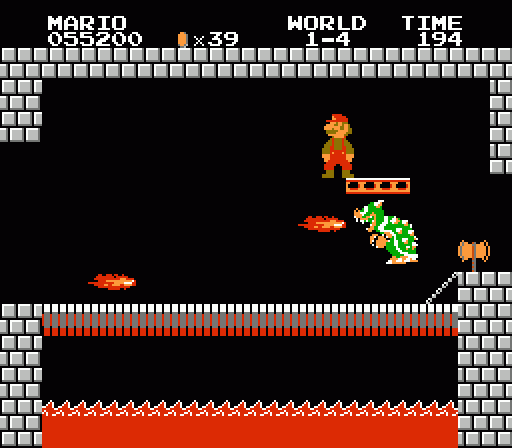
And, finally, we come to Bowser himself. The main villain of the piece does very little to stop you, surprisingly enough. He shoots those licks of flame, sure, but other than that he just kind of shuffles back and forth and makes tiny jumps. It’s simple enough to sail over his head, even without the little platform floating above his head to ease the way.
The game ceases its scrolling here to convey the sense that, hey, this is the end, so you have plenty of space to sort out a strategy. Bowser sticks to the right side of the screen, leaving you ample room to dodge his fire and build up a leap.
But what to do? Bowser’s spiny back and horned head make him deadly to jump on; unlike every other foe in the game, he can’t be beaten with a jump. I don’t know that this is entirely intuitive, and I think the designers would have been smart to have introduced Spinies — the game’s other jump-proof foe — prior to Bowser to teach players the notion that “spikes = bad.” I can’t speak for other players, but my first instinct when I first met Bowser was to stomp him, which proved to be a bad idea.
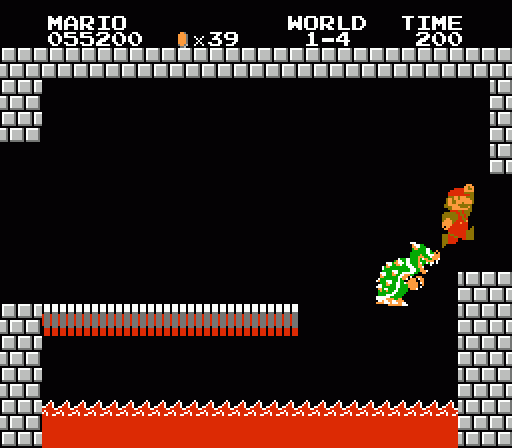
Rather than face Bowser directly, what you need to do is destroy the ground under his feet. Conveniently, someone stashed an emergency axe right next to the chain holding this bridge up. Beating Bowser is as simple as leaping over him and touching the axe, which instantly slices through the chain and causes Bowser’s footing to retract. One comical Wile E. Coyote footscrabble later and he plunges into the lava. You win! Game over. Advance and save the princess.
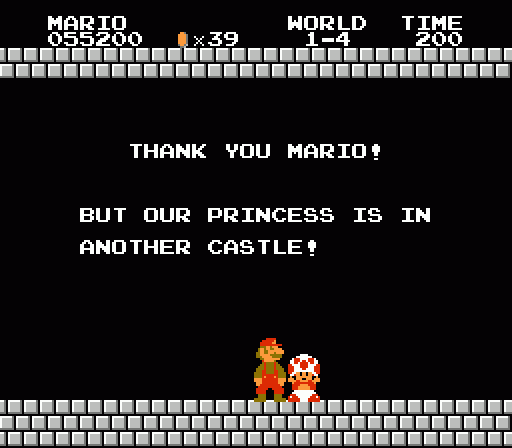
Oops, sad trombone music plays in your mind to underscore the triumphant in-game jingle: You haven’t won after all. This is not the end of the game, merely a false victory. The princess is elsewhere, and instead you’ve saved a tiny fat creature in a mushroom hat.
In the context of the time, this is a pretty good gag. Mario’s previous platformer outings — Donkey Kong and Donkey Kong Jr. — each consisted of four different stages with a “boss” showdown at the end. And there, as here, you won by destroying the ground beneath the boss’ feet rather than confronting him directly. Super Mario sticks closely to the Donkey Kong formula in this regard… but once you reach the “end,” you discover you’ve only cleared an eighth of the adventure.
Certainly action games with a large amount of content weren’t unheard of in 1985 — Pitfall II was pretty huge! — but no one had seen anything on the scale of Super Mario‘s 32 unique levels on a console before. Not only was it the best-playing action game to date, it was also the biggest.
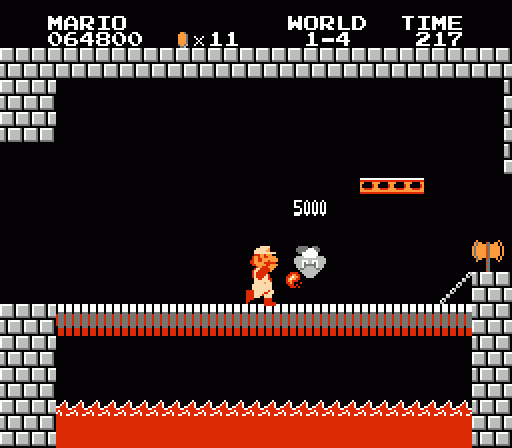
And, of course, Mario did have an alternative means for beating Bowser: Fireballs. If you’re able to hang on to a Fire Flower from World 1-3 (or just enter the stage as Super Mario and snag the power-up above the fire bar between the lava pits), you can fight fire shafts with fire balls. A few hits takes out Bowser, at which point you’ll make an interesting discovery: When defeated, “Bowser” turns out to be nothing more than a Gloomba in disguise. The whole thing was a sham! It’s a neat little detail that demonstrates Shigeru Miyamoto’s love for story-telling through gameplay… something weirdly absent from most modern Nintendo games.
There was already a foe presented that you couldn’t beat by jumping, the Piranha Plant. Now his chomping mouth and big teeth make his imperviousness a little bit more evident than the little spikes on Koopa’s back, but the concept wasn’t completely new at this point.
Hm, yeah, I take your point, but those are more akin to scenery (like the fire bars). Bowser resembles Koopa Troopas, as do Spinies, so I think the design language would be a little clearer if maybe one of them had trotted along at some point in World 1-2. Surprise, you’re dead! But now you won’t die when you see Bowser.
Is it possible Bowser was meant as the primer to Spinies? Also, I always thought the visual of an ax was used as a lure. Kids would see it and go “Hey, a weapon to fight the boss with!” Personally, I always saw it as a level, but I have no idea why my 12 year old self didn’t see it as an axe. :/
BTW, it is interesting to see these early levels get analyzed. Once I found out about warp pipes, I don’t think I ever played any world prior to 3, so I have little to no exposure to them.
That wouldn’t make any sense, hierarchically. Why use a rare enemy boss to communicate the nature of common monsters? Besides, any lesson you take from Bowser wouldn’t necessarily translate intuitively, as he resembles a turtle but still represents a unique threat. Going from Koopas to Spinies to Bowser offers a logical progression of threats.
Back when I first burned Bowser to death, I thought the random enemies were just odd placeholder graphics due to NES limitations. It wasn’t until I burned the real Bowser to death along with the other seven in Super Mario Bros. Deluxe that I realized the the other Koopa Kings actually were mooks transformed into him.
There’s a lot you would never know unless you read the NES manual, like Bowser being a powerful sorcerer and all those bricks you’ve smashed being Mushroom Kingdom residents.
Stupid admission: I never saw the blocks you were breaking as Mushroom Kingdom residents. As a kid, I thought the bricks that made up the ground you walked on in most levels resembled people holding hands and I always assumed that’s what the manual was talking about.
IIRC, they actually made his head a little spikier-looking and more obviously dangerous in SMAS.
I never knew that, about a fireballed Bowser turning into a (pallete swapped?) enemy. Informative!
The bowser guises hide more and more impressive or difficult foes until 8-4 which is the real bowser. Its a pretty neat touch.
Although I think the bosses of Mario improved even more when you move to SMB3.
This series is insanely good
When I was younger, I always thought the Spinies were the first real challenge as far as enemies go. Bowser is easier, plain and simple. What I mean is - putting the spinies out there before Bowser might have been too difficult for the game’s first world. However, I definitely see your point. But after all, this is an NES game - you’re meant to learn through failure. You jump on him - you die or shrink, and lesson learned. Sometimes it’s just gotta be the hard way.
By the way, I think this is your best Anatomy series yet. Like you, I wasn’t sure I’d be interested in reading that much more about such an ubiquitous game, but I was wrong… this is some damn good stuff.
Also, I would argue that, given the ominous music, the new locale, the stopped-scrolling screen, and the bigger, more detailed sprite, it would be pretty obvious that this isn’t your average baddie, and probably won’t succumb to your average attacks.